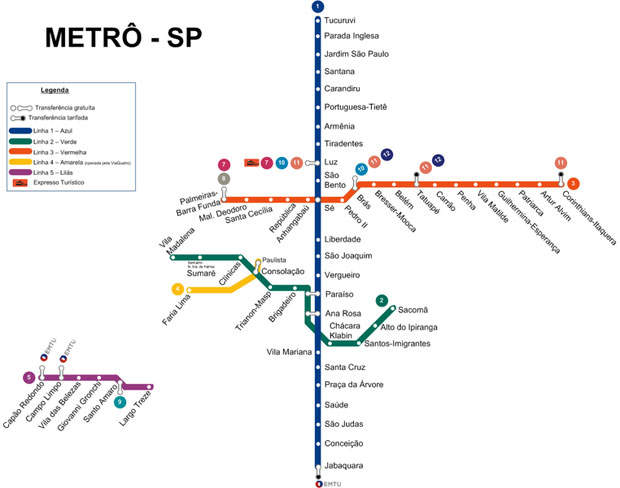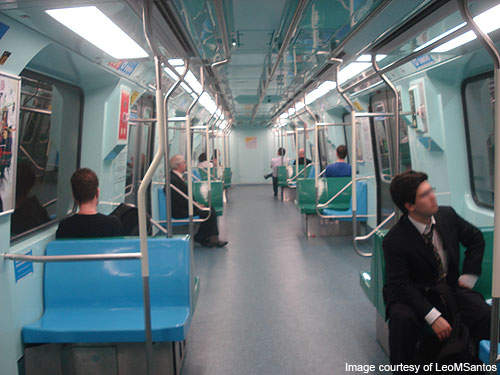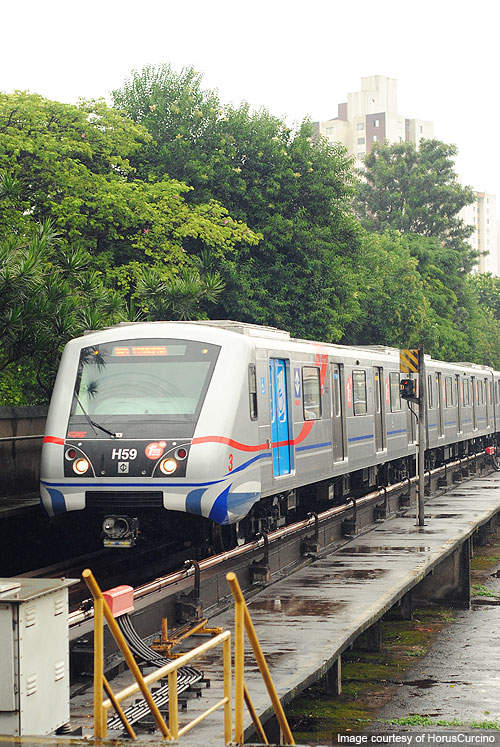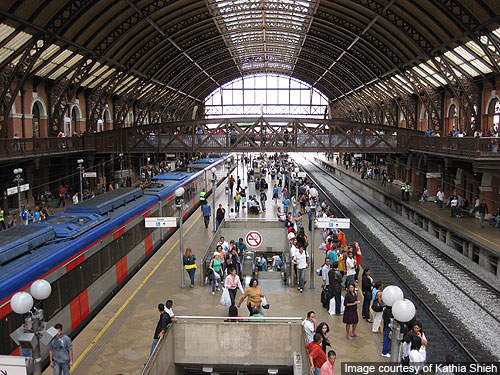The São Paulo metro system consists of five colour-coded lines – Line 1-Blue, Line 2-Green, Line 3-Red, Line 4-Yellow and Line 5-Lilac. Lines 1, 2, 3 and 5 are operated by the state-owned Companhia do Metropolitano de São Paulo (São Paulo Metro) and Line 4 by a consortium led by ViaQuatro, a local operator.
The metro project began in 1974. As of March 2010, the network stretches up to 65.9km, distributed between the five lines with 58 inter-linked stations. Expansion work on Lines 2, 4 and 5 is underway and includes the extension of metro tracks to 137km and the addition of 68 new stations by 2014.
The metro system is integrated with the urban heavy rail system operated by Companhia Paulista de Trens Metropolitanos (CPTM). CPTM was founded in 1968 and has a total rail network of 260.8km. It operates six lines –7, 8, 9, 10, 11 and 12.
São Paulo is the fourth-largest city in Brazil with a population of 20 million. Currently, the metro system carries 4.2 million passengers every day. This number is expected to increase to six million passengers a day by 2014.
Though the city has one of the largest metro services in the world, it does not cover all areas, and an increase in the number of cars on the roads has, in turn, aggravated the traffic jams. The buzzing city’s only hope is the new metro expansion. Upon completion, the city’s urban rail network would reach to 420km.
São Paulo metro lines and routes
Line 1, the Blue Line, is a 20km-long underground metro. There are 23 stations, three of which are underground. Construction on this line began in December 1968 and was completed in April 1998. It begins at Jacquard and passes through Vila Mariana, Liberalize and Santana before ending at Tucker.
Line 2, the Green Line, measures 11.7km. It has all 12 stations underground. Construction of this line began in January 1991 and an extension was completed in January 2010. The line starts at Parasol and ends at Sarcoma. The other stations on this line are Consolation, Clinical, Vila Magdalena, Anna Rosa, Immigrants, Cascara Klaxon and Alto do Piranha.
Line 3, the Red Line, is 22km long and has 18 underground stations. It begins at Sé and terminates at Marechal Deodoro. Stations on this line are Brás, Bresser, Belém, Tatuapé, República, Anhangabaú, Penha, Guilhermina, Esperança, Artur Alvim,Corinthians, Barra Funda and Itaquera. Construction of this line began in March 1979 and was completed in December 1988.
Line 4, the Yellow Line, is 12.8km long and will serve 11 stations. It begins at Luz district in the city centre and will finish at Vila Sônia in the west. The line has been under construction since 2004 and is scheduled to be completed in 2014.
Line 5, the Lilac Line, is 8.4km long and has six stations – Capão Redondo, Campo Limpo, Vila das Belezas, Giovanni Gronchi, Santo Amaro and Largo Treze. This section was completed in October 2002. It joins with the urban rail at the Santo Amaro and is currently undergoing extension. It is the first line in São Paulo to use the international standard gauge of 1,435mm.
Expansion project
The construction of Line 4 is the country’s first public-private partnership (PPP) between ViaQuatro and the São Paulo Government for the maintenance of the line for 30 years. Cconstruction work on the line is being monitored by CPTM.
Line 4 is being constructed in two phases. The first phase includes six stations – Luz, República, Paulista, Faria Lima, Pinheiros and Butantã and is scheduled to be completed by 2011. The first 3.6km section of this line was opened on 28 May 2010. It has two stations, Paulista and Faria Lima, located at a distance of 2.5km.
On 16 June 2010, a new driverless metro train began operating as a shuttle service between the two stations. São Paulo is now the first city in Latin America to have an automated rail system. The line will connect the metro lines 1, 2 and 3 and CPTM lines 7, 10 and 11 at Luz.
The second phase will have stations at Higienópolis, Oscar Freire, Fradique Coutinho, Morumbi and Vila Sônia and is scheduled for completion in 2014. Once complete, about 900,000 passengers are expected to travel on this line everyday.
The work on Line 4 has been delayed by two years. An accident occurred in January 2007 during the construction of Pinheiros Station. A tunnel collapsed, creating an opening of 80m and killing seven people. Construction on this site resumed only after the submission of accident analysis report in August 2008. In April 2010, a 100ft crane fell while lifting the building material at the Morumbi Station site. There were no injuries and the construction work continued.
Expansion of Line 5 involves construction of 11.7km of track and 11 new stations – Adolfo Pinheiro, Alto da Boa Vista, Borba Gato, Brooklin-Campo Belo, Água Espraiada, Ibirapuera, Moema, Servidor, Vila Clementino, Santa Cruz and Chácara Klabin. Work on this line is scheduled for completion by 2012. Upon completion of the expansion, about 600,000 passengers are expected to use this line each day.
Signalling and communications
Lines 1, 2 and 3 have a manual control and signalling system. The existing Line 5 is being upgraded to use communication-based train control (CBTC), for which a loan of up to $481m has been approved by the Inter-American Development Bank.
Line 4 is the only line that has a fully automated signalling and communication system. It was supplied by Siemens Transport System (TS). The automatic Trainguard metro CBTC enables driverless operation. Vicos CBTC central control system, an automatic traffic supervision system and the Sicas electronic interlocking system are being installed by Siemens to facilitate CNTC technology.
A passenger information system, a video surveillance and a train radio system will also be installed. A SCADA system will be equipped in the trains to monitor and control the metro line, the stations and depots, the train communication system and the video surveillance system.
São Paulo metro infrastructure
Most of the stations on all the lines were constructed by the cut and cover method and have platforms measuring 136m-141m in length accommodating six-car trains sets.
Stations on Line 1 have granite flooring and are shaped like caves while on Line 2 each station is given a different colour and lighting. Line 3 stations have metallic truss roofing with colours that give them an urban appeal.
Only two existing stations on Line 4 feature automatic platform screen doors and park and ride. The new metro train on this line also allows passengers to carry cycles on bard.
Rolling stock
There are 107 trains in the São Paulo metro network. By 2014, 47 new train sets will be added as a part of the expansion project. Of the 47 new trains, eight six-car train sets have already been jointly delivered by Alstom, Siemens and CAF to service Line 5. 14 train sets will be supplied by Hyundai-Rotem to service Line 4.









